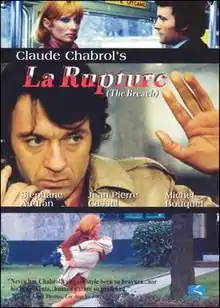The Breach (film)
The Breach (French: La Rupture), also titled The Breakup, is a 1970 French–Italian–Belgian drama film written and directed by Claude Chabrol, based on the novel The Balloon Man by Charlotte Armstrong. It follows a mother's struggle for custody of her son against her husband's parents.
| The Breach | |
|---|---|
 DVD cover | |
| La Rupture | |
| Directed by | Claude Chabrol |
| Screenplay by | Claude Chabrol |
| Based on | The Balloon Man by Charlotte Armstrong |
| Produced by | André Génovès |
| Starring | Stéphane Audran Jean-Pierre Cassel Michel Bouquet Annie Cordy |
| Cinematography | Jean Rabier |
| Edited by | Jacques Gaillard |
| Music by | Pierre Jansen |
| Distributed by | Gaumont Film Company (France) New Line Cinema (US) |
Release date |
|
Running time | 125 minutes |
| Countries | France Italy Belgium |
| Language | French |
| Box office | $5,566,068[1] |
Plot
Hélène Régnier's drug-addicted husband Charles injures their son Michel in a violent rage. She beats Charles to the floor with a frying pan, flees with Michel and moves into a boarding house next to the hospital where Michel is recovering. Hélène starts divorce proceedings with the help of lawyer Allan Jourdan, who offers to support her case although she can hardly pay him. Meanwhile, Charles' wealthy and manipulative parents, who never approved of his marriage, take their son back in, determined to secure custody of Michel. Ludovic Régnier hires Paul Thomas, a family acquaintance whose father lost his money due to Ludovic's business operations, to find damaging material on Hélène. Paul moves into the boarding house and, with the help of his girlfriend Sonia, plots to ruin Hélène's reputation. In the end, the plot fails. The final images show Hélène, induced with drugs by Paul, wandering around in a fantasised world, while the outcome of the custody case is left open.
Cast
- Stéphane Audran as Hélène Régnier
- Jean-Pierre Cassel as Paul Thomas
- Michel Bouquet as Ludovic Régnier
- Michel Duchaussoy as Allan Jourdan
- Annie Cordy as Mme. Pinelli
- Jean-Claude Drouot as Charles Régnier
- Jean Carmet as Henri Pinelli
- Catherine Rouvel as Sonia
- Claude Chabrol as passager in the tramway
Release
The Breach was released on 26 August 1970 in France,[2] where it had a total of 927,678 admissions.[1] On 4 October 1973, it premiered at the New York Film Festival.[3]
Reception
Upon the film's premiere at the New York Film Festival, Vincent Canby of The New York Times wrote a sympathetic yet mixed review. While acknowledging that it has "many beautiful things in it", the "disadvantages and indignities are piled so thickly on the poor heroine that one knows early that the film is obliged to offer her vindication", which itself "isn't surprising or touching enough to transform the melodrama of "La Rupture" into tragedy".[3]
In his 1985 review for the Chicago Reader, Dave Kerr's resume was thoroughly positive, calling La Ruptire one of Chabrol's key films of the 1970s and a "most audacious experiment with narrative form… which begins with clear black/white, good/evil distinctions and then gradually self-destructs, breaking down into increasingly elliptical and imponderable fragments".[4]
In her book Claude Chabrol's Aesthetics of Opacity (2018), Catherine Dousteyssier-Khoze sees Chabrol "veering away from any realist anchoring and venturing into the realm of the symbolic". With the film being strongly influenced by the fairy tale, the characters become markers of this genre, with Hélène as the "beautiful princess or good fairy", Paul Thomas as "the evil witch", the ladies at the boarding house as Parcae and Ludovic Régnier as "the incarnation of pure evil".[5]
References
- "La Rupture". JP Box-Office (in French). Retrieved 28 May 2015.
- "La Rupture (1970) Claude Chabrol". Ciné-Ressources (in French). Retrieved 29 May 2023.
- Canby, Vincent (5 October 1973). "Screen: 'La Rupture'". The New York Times. Retrieved 23 August 2011.
- Kehr, Dave (26 October 1985). "La rupture". Chicago Reader. Retrieved 23 August 2011.
- Dousteyssier-Khoze, Catherine (2018). Claude Chabrol's Aesthetics of Opacity. Edinburgh University Press. p. 121. ISBN 9780748692606.
External links
- The Breach at IMDb
- The Breach at AllMovie